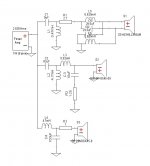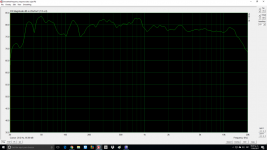Xover to add super-tweeter in a 3 way loudspeaker, I have laying around a couple of Focal TC120TDX2 that I want to use as super tweeter in my current 3 way system. Need help for suggestions what frequency to cross them, attached xover used in the current 3 way loudspeaker & Focal datasheet.
FR two loudspeakers smoothing 1/3

IR two loudspeakers

What about using a xover at 15kHz 2nd order 12dB/octave 3dB slope @ fx?
FR two loudspeakers smoothing 1/3
IR two loudspeakers
What about using a xover at 15kHz 2nd order 12dB/octave 3dB slope @ fx?
Attachments
Last edited:
Unless it's positioned in the very nearby, it will be barely audible. That's why the usual supertweeters are high sens/High eff. with L-pad or transformer/autoformer.
Try to position a waveguide ( it can be made with a cone of a dead speaker ) on the tweeter and see how it gains. For Fc=10 kHz its diameter being 344/10000=3,4 cm WL
Try to position a waveguide ( it can be made with a cone of a dead speaker ) on the tweeter and see how it gains. For Fc=10 kHz its diameter being 344/10000=3,4 cm WL
single cap , 10Khz, refine from there
Thank you I will try. Slope 3 or 6dB?
Another view on the seas design : a) resistor in series b)a lowpass?
Between the attenuation resistor R1 and the tweeter is a filter for time delay alignment
Last edited:
Here's what I have done in the past. I have plenty of capacitors and inductors in my parts boxes which obviously helps! Get a variable L-Pad and some inexpensive capacitors and a few inductors. Calculate L and C values for X/O's at say 8 KHz, 10 KHz and 12 KHz for starters. Do this for 1st order and second order X/O both. Pick a place to start; usually the highest frequency first and do listening tests using a capacitor only (1st order). Start adding capacitors in parallel, these can be low value like 0.22 uF, 0.33 uF, 0.47 uF, etc. one at a time while doing listening tests. If you get to the point where you think the tweeter is adding too much output, try an inductor for 2nd order. I use alligator clip leads to quickly allow connecting and disconnecting capacitors and inductors. Also, tweeter polarity may be an issue depending on what X/O freq. and slope you end up with. You can use a DPDT switch to quickly reverse polarity. It helps if you have a partner do these things for you while you sit in your "normal" listening position. Based on my hearing loss and others; I would also say to start at about 12 KHz, then 10 KHz, etc. If I were to guess, you will probably end up with 2nd order, 12 KHz, reverse polarity; with little to no L-Pad attenuation. Regardless of what others may say or think; it has helped "ME" get the most out of the top octave by experimenting in this way. Once you have this all fine tuned to "YOUR" personal taste and listening preference; replace the adjustable L-Pad with high quality fixed resistors and the caps. and coils with a higher quality as well. Of course, if you have access to test and measurement equipment, calibrated microphones, etc. you can do these experiments in a much more scientifically correct manner. In my case it doesn't matter; what I need is top octave boost based on listening tests that match "MY" hearing loss. Again, everyone's tastes are different, everyone's hearing loss is different; do not be afraid to experiment.
Here's what I have done in the past. I have plenty of capacitors and inductors in my parts boxes which obviously helps! Get a variable L-Pad and some inexpensive capacitors and a few inductors. Calculate L and C values for X/O's at say 8 KHz, 10 KHz and 12 KHz for starters. Do this for 1st order and second order X/O both. Pick a place to start; usually the highest frequency first and do listening tests using a capacitor only (1st order). Start adding capacitors in parallel, these can be low value like 0.22 uF, 0.33 uF, 0.47 uF, etc. one at a time while doing listening tests. If you get to the point where you think the tweeter is adding too much output, try an inductor for 2nd order. I use alligator clip leads to quickly allow connecting and disconnecting capacitors and inductors. Also, tweeter polarity may be an issue depending on what X/O freq. and slope you end up with. You can use a DPDT switch to quickly reverse polarity. It helps if you have a partner do these things for you while you sit in your "normal" listening position. Based on my hearing loss and others; I would also say to start at about 12 KHz, then 10 KHz, etc. If I were to guess, you will probably end up with 2nd order, 12 KHz, reverse polarity; with little to no L-Pad attenuation. Regardless of what others may say or think; it has helped "ME" get the most out of the top octave by experimenting in this way. Once you have this all fine tuned to "YOUR" personal taste and listening preference; replace the adjustable L-Pad with high quality fixed resistors and the caps. and coils with a higher quality as well. Of course, if you have access to test and measurement equipment, calibrated microphones, etc. you can do these experiments in a much more scientifically correct manner. In my case it doesn't matter; what I need is top octave boost based on listening tests that match "MY" hearing loss. Again, everyone's tastes are different, everyone's hearing loss is different; do not be afraid to experiment.
Thanks for the idea about how to setup.
Just a note. If you resize your images to no larger than 1200 pixels wide, they fit better on the page. 1900 (yours) is really too wide for browser windows.
Do you know how to resize?
Unless it's positioned in the very nearby, it will be barely audible. That's why the usual supertweeters are high sens/High eff. with L-pad or transformer/autoformer.
Try to position a waveguide ( it can be made with a cone of a dead speaker ) on the tweeter and see how it gains. For Fc=10 kHz its diameter being 344/10000=3,4 cm WL
Really diameter 3.4cm?
Yes I'm old but when I listen a super tweeter there is a sensation of air or open sound that I want to replicate in my system.
And is your opinion based on the extremely simple test needed to test it blind by simply having a buddy turn the super-tweeter on and off? Could the placebo effect (for want of a more pejorative term) be alive and well?
Dick Hertz: +1... you're asking the right question.
Not always an improvement in SQ to enhance top or bottom end without simultaneously enhancing bottom and top end.
B.
- Status
- This old topic is closed. If you want to reopen this topic, contact a moderator using the "Report Post" button.
- Home
- Loudspeakers
- Multi-Way
- Xover to add super-tweeter in a 3 way loudspeaker

